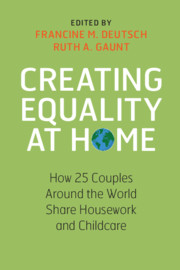Book contents
- Creating Equality at Home
- Advance Praise for Creating Equality at Home
- Creating Equality at Home
- Copyright page
- Dedication
- Contents
- Contributors
- Acknowledgments
- Development and Gender Equality in Participating Countries
- Setting the Stage
- Consciously Creating Equality
- Violating Social Norms
- Prioritizing Family
- Drawing on Lessons from Families of Origin
- Using Government Policies
- What We Have Learned
- 26 Undoing Gender: Different Cultures, Similar Stories
- 27 Conclusion: The Paths to Equality
- Index
- References
27 - Conclusion: The Paths to Equality
from What We Have Learned
Published online by Cambridge University Press: 03 June 2020
- Creating Equality at Home
- Advance Praise for Creating Equality at Home
- Creating Equality at Home
- Copyright page
- Dedication
- Contents
- Contributors
- Acknowledgments
- Development and Gender Equality in Participating Countries
- Setting the Stage
- Consciously Creating Equality
- Violating Social Norms
- Prioritizing Family
- Drawing on Lessons from Families of Origin
- Using Government Policies
- What We Have Learned
- 26 Undoing Gender: Different Cultures, Similar Stories
- 27 Conclusion: The Paths to Equality
- Index
- References
Summary
The concluding chapter describes the equal sharers as nonconformists, resisters of gendered norms, and recounts the social criticism that their lifestyle can evoke. The chapter identifies factors across diverse cultures that enable this resistance. They include couples’ conscious adoption of egalitarian principles and insistence that they be put into practice, which often entails women’s sense of entitlement to equality, and their ongoing communication with their partners. In addition, anti-essentialist beliefs, familism, and anti-materialism underwrite their equality. Lessons from their families of origin, whose lives they either imitate or reject also encourage their resistance to gendered norms. Finally, the chapter enumerates the rewards equal sharing provides for men, women, marriage/partnership, and children.
Keywords
- Type
- Chapter
- Information
- Creating Equality at HomeHow 25 Couples around the World Share Housework and Childcare, pp. 366 - 394Publisher: Cambridge University PressPrint publication year: 2020
References
- 2
- Cited by

